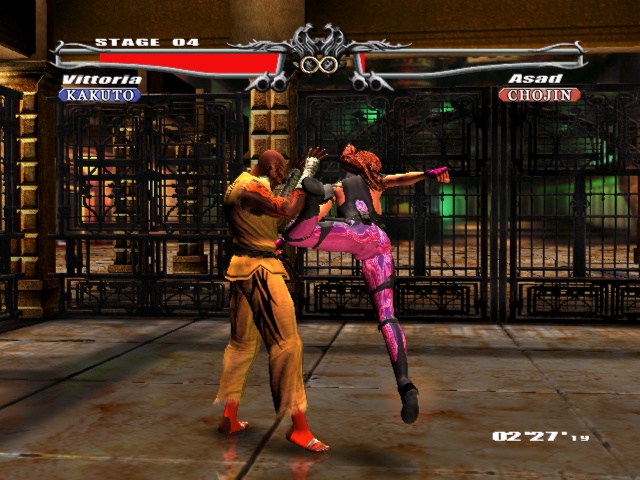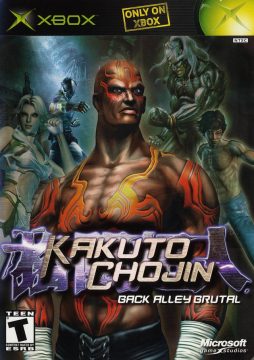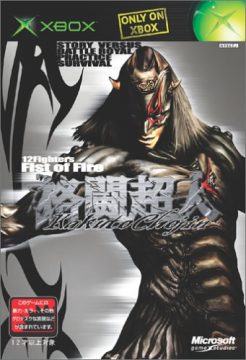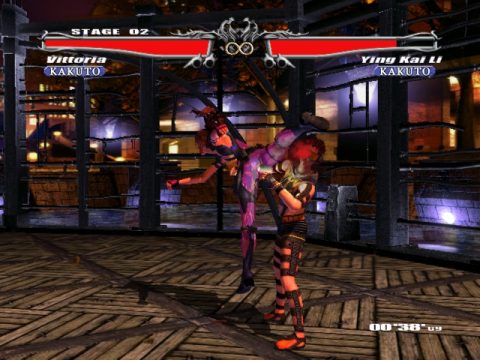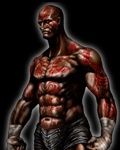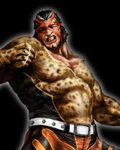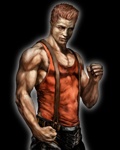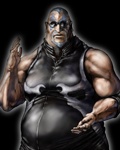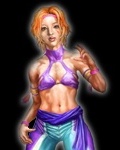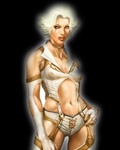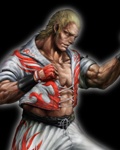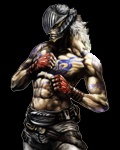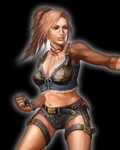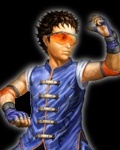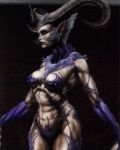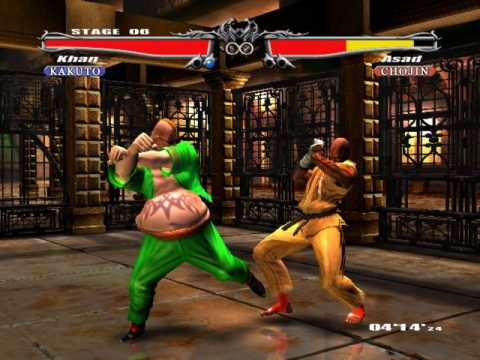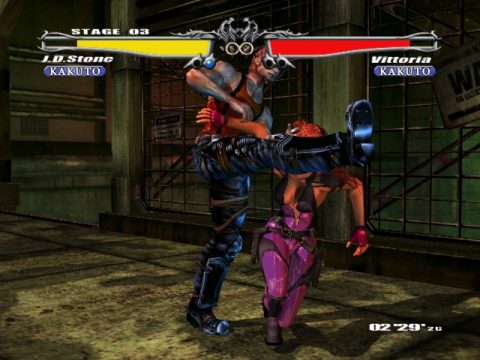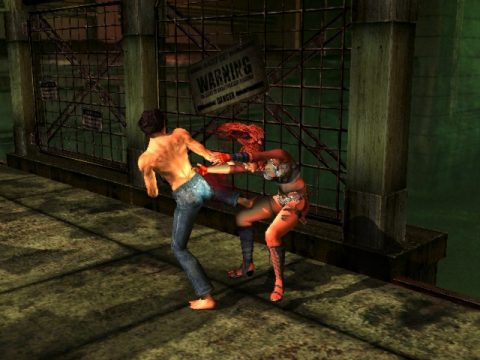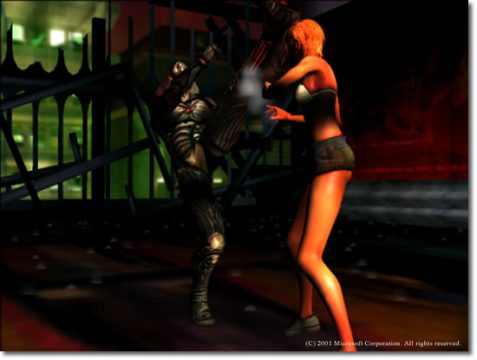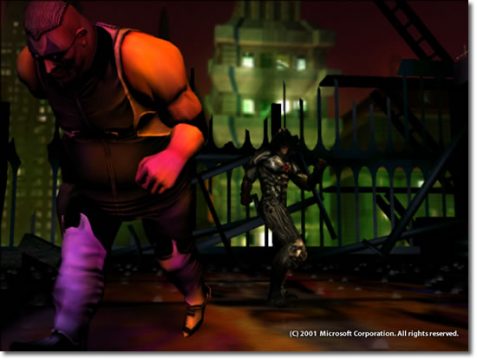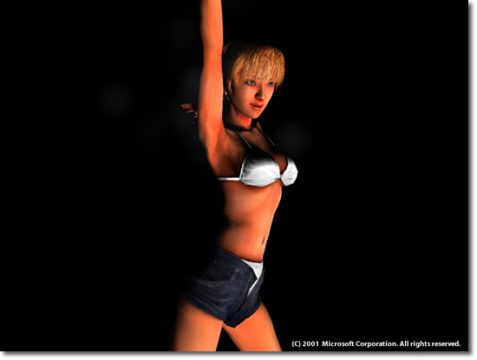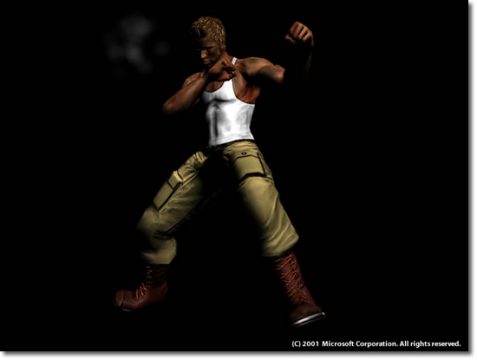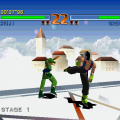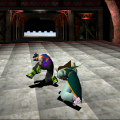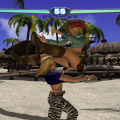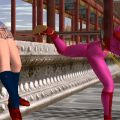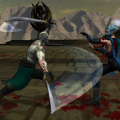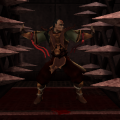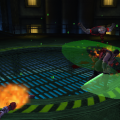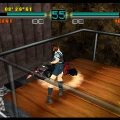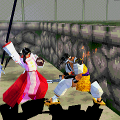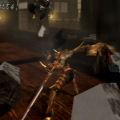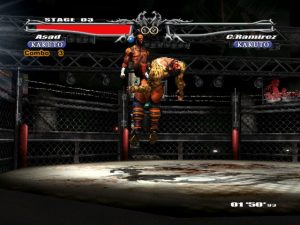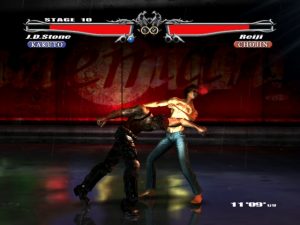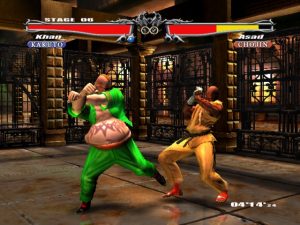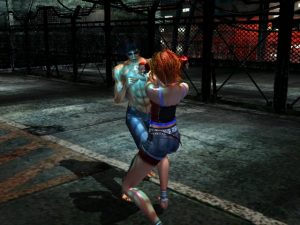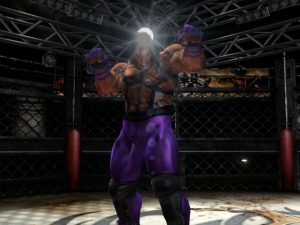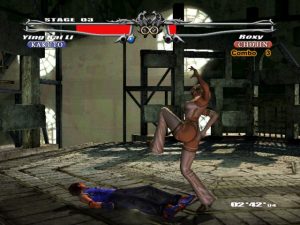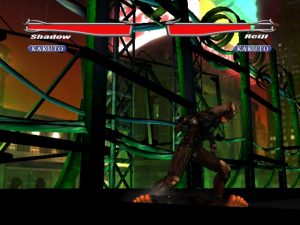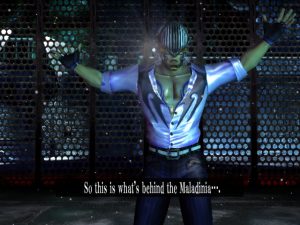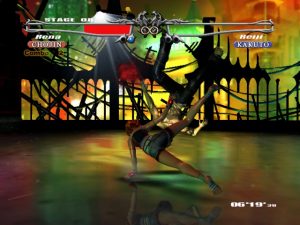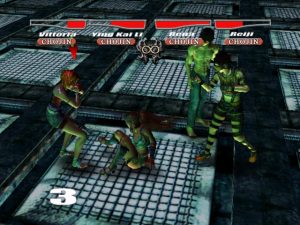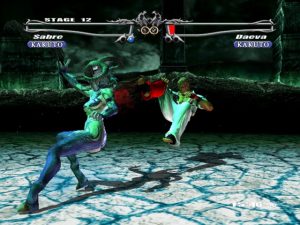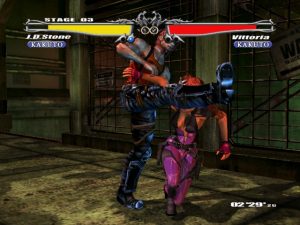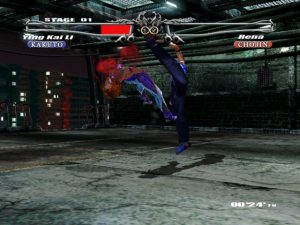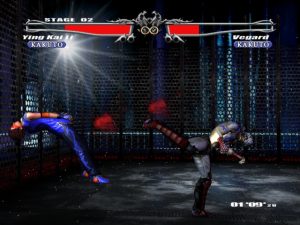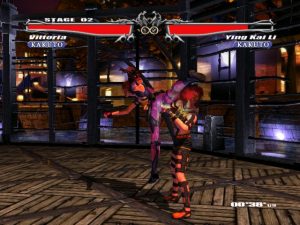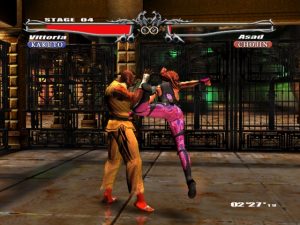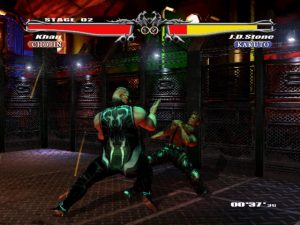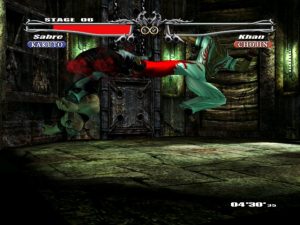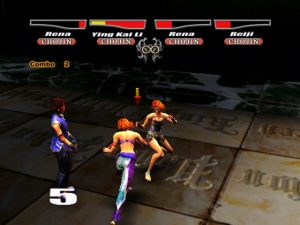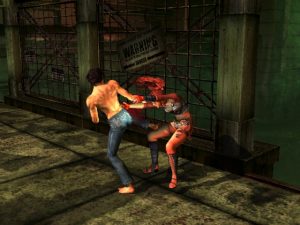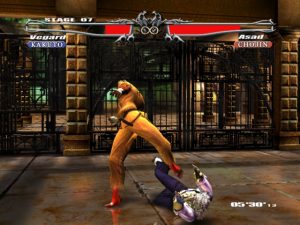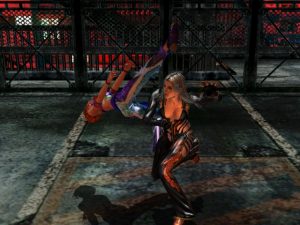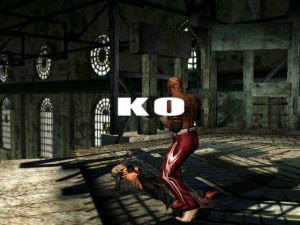The original Xbox wasn’t exactly known as the definitive fighting game machine, but Microsoft sure tried to make it such. Neglected by the big two, Virtua Fighter and Tekken, the console launch was supported by Xbox-fan Tomonobu Itagaki and his Dead or Alive 3, but that series was never taken seriously by the majority of the fighting game community. Team Ninja also seemed dead-set on never releasing more than one major numbered iteration of their flagship title per console cycle (although they delivered an epic gap-filler with Dead or Alive Ultimate), so Microsoft had to look for alternatives to strengthen their martial arts lineup. Several 3D fighters presented by Microsoft Game Studios were the result, but none of them succeeded in making any impact whatsoever on the scene or the market. The first – and most forgotten – of these games was Kakuto Chojin.
At first, the auspices seemed promising: Dream Publishing wasn’t a widely known name, but raised eyebrows where it was recognized as a variant of DreamFactory, who produced the Tobal and Ehrgeiz series. Producer and designer Seiichi Ishii had originally been responsible for the very first Virtua Fighter under Yu Suzuki. Soon after, he joined Namco to also create Tekken, together with his partner in crime, director Kunihiko Nakata, who in between had made his own name known through Bushido Blade. Lots of fighting game experience on some of the most iconic 3D series, as well as some of the more unique and memorable games in the genre therefore spoke for the team, and in early presentations the game was showcased as one of the big killer apps for Microsoft’s start into the console market, so what could possibly go wrong? Well, first of all, the game all but vanished very shortly after its release.
It vanished, not just in the sense of “from the memory of gamers,” but was very physically removed from store shelves. As it happens, one of the characters in the game, Asad, is depicted as a devout Muslim on his own private jihad, complete with quotes like “Beating me is against God’s will.” and reportedly phrases of the Koran chanted in his stage music. Now who thought that would be a great idea, little more than one year after 9-11? Suffice to say, certain parties got all worked up about Asad, whereupon Microsoft demonstrated a severe lack of backbone and just recalled the game. In Japan, it was available for no more than a couple of weeks, while a European release didn’t take place to begin with. Everyone at the time was kinda expecting a modified re-release, but it never happened. Reviewers had slandered the game good by then, and sales so far hadn’t been that impressive, either, so the Windows company decided to just pretend the game never existed.
An unfortunate chain of events, for despite the number of flaws the game certainly had, it brought a number of interesting elements to the table for the ever stagnant fighting game genre. While not a great game by any stretch (which neither the first Tekken nor the first Dead or Alive were, to put things in perspective), it could have been the start of an interesting series, had it been given a chance. As it were, though, the tragedy marked not only the end of Kakuto Chojin, but also pretty much DreamFactory’s fighting game career, save for an anime-licensed all girls wrestling game that ironically had “Kakuto” in its title, as well. All that for one politically incorrect character (and the nature of professional game criticism), while the rest of the game’s roster is conservative enough for a fighting game, although it does mix up its fighting discipline stereotypes with some more rarely seen nationalities between the obligatory share of Japanese, Chinese and US fighterrs.
One thing the game does particularly bad is the storytelling, and saying that for a fighting game means it’s really bad. The only part in the game that ever hints at some sort of story are the characters’ endings, which all consist of no more than two short paragraphs of plain text, before the game cuts to the credits in front of a training choreography (/dancing choreography for the female fighters). The reason the world’s greatest warriors came together is called the Fist of Fire Tournament this time, hosted by an evil organization called the Maladinia, which is pretty much the Mishima Zaibatsu, only without a leader as bad-ass as Heihachi.
Characters
Asad
The culprit that got the game banned was even the main focus on the US cover for the game. He is also probably the only fighting game character ever to have Somalia as his stated place of origin. The martial arts discipline he employs to fight in the name of God is Muay-Thai, which equips him with some wicked counter moves.
Crusher Ramirez
The pro wrestler for people that hate to play wrestling characters, as he boasts a repertoire of a whole two (!) grappling moves (most other characters have to make do with only one). Otherwise, his design is the stereotypical angry, masked South American (he’s from Argentina) wrestler without much of a characterization.
J.D. Stone
The first of two US American characters is a pit fighter. His fighting style is based on evasive maneuvers similar to Virtua Fighter‘s Brad Burns. It seems as if Stone is there to bring back the good old tradition of basing fighting game characters off action movie heroes, in this case Tyler Durden from Fight Club.
Khan
Apparently Khan used to be with the Maladinia before the tournament, until he killed Reiji’s foster father (who accordingly apparently was also part of the organization). But we all know the true reason he’s in the game is because every fighting game needs its own fat Hong Kong kung fu ganster…
Reiji
… just as every fighting game needs its own Bruce Lee clone. To put a twist to the cliche, in this game it’s a Japanese Tomonobu Itagaki lookalike with massive scars all over his body. The typical Bruce Lee screams seem mightly misplaced with his ever-calm face, bare of any lip-synching whatsoever.
Rena
The capoeira dancer Rena is another character that just wouldn’t be Japanese in any other fighting game. There’s something very unique to her visual design. Fighting game females just don’t look normally like that.
Roxy
Roxy is the game’s evil kung fu bitch. Her fighting style, without being an expert (and without the game explicitly stating so), resembles Mizongyi. When she wins the tournament, she takes over the Maladinia.
Sabre
The karateka from France has this Ryu story arc going on, where he travels the whole world in order to find worthy opponents and perfect his fighting.
Shadow
Shadow has lost his identity and all is memories and since went on a spree of senseless fighting. It is hinted that he might actually be Vittoria’s missing brother, which doesn’t make him a clone of Dead or Alive‘s Ein/Hayate at all. Many of his moves also seem like a mix of DOA‘s ninjas.
Vegard
This guy from Norway is legitimately insane. After winning the tournament, he just blows himself up. Fighting Style: Tae Kwan Do (yes, they write it that way).
Vittoria
Vittoria hails from Spain and is looking for her missing brother who might or might not be Shadow.
Ying Kai Li
The obnoxious kung fu (Bajiquan in this case) brat every fighting game nowadays seems to have and no one really wants.
Play options aren’t blessed with abundance, either. For single players, there’s only story mode, practice and survival. The latter has one fighting against three opponents at a time, who have to be knocked down on their asses as much as possible. For this the game switches to a Wu Tang: Shaolin Style like mode, which is also used by most multiplayer modes. Besides the standard 1-on-1, two modes use that engine here: Capture the Crown, where everyone is after the eponymous item, and a simple free-for-all Battle Royal. On one hand this kind of mode is somewhat encouraged by the fighting engine, as the combatants aren’t as strictly locked into facing each other as in other fighting games. It still appears, however, painfully clear that the developers forced themselves to include simultaneous 4-player gameplay, as these modes lack a vision of what to do with them and are rather boring and chaotic.
The biggest gripe everyone had with Kakuto Chojin, however, was with the perceived lack of variety in combat. The title Kakuto Chojin describes the game’s basic philosophy – every character would have a distinct “Kakuto” moveset, and a “Chojin” alternative. Kakuto is supposed to be the easy and more simple one, while Chojin supposedly forced stricter timing and had its movelist hidden, but rewarded this with a greater variety of combos. There are two vital flaws, however, that come with this concept. First, the overall movesets and combo lists aren’t nearly large enough to support two seperate styles, which makes especially Kakuto mode suffer. Chojin relieves that to a degree – although the average move count is still well below any vaguely contemporary Virtua Fighter or Tekken game, characters have more combos in this mode and many play out significantly more fluidly, most notably in characters like Rena, who is an insult to Capoeira in Kakuto but feels just right in Chojin mode.
Which leads directly to the second issue. Most characters are much more fun to play as their Chojin variants, and after unlocking them, most players won’t ever go back to Kakuto. But that’s the problem: Chojin has to be unlocked for each and everyone separately by finishing story mode with that fighter. So even players who just want to play in versus mode have to get ready for the chore of finishing the story 13 times against awfully defensive CPU opponents. It’s a task especially time-pressed reviewers are more often than not unwilling to perform before getting to the good part, resulting in reviews that mostly represent the Kakuto experience.
But when looking a bit closer, Kakuto Chojin actually has a few interesting elements that set it apart from the mainstream series that are basically the same game in each iteration. For once, action buttons are not strictly divided into punches and kicks. Instead, the three main buttons represent high, middle and low attacks, which can be either of the aforementioned two depending on the situation, comparable to the strong attack button in part of the Real Bout series. Besides the obligatory block and a running button, pressing all three attacks at the time (although there’s also a shortcut for that) activates a special glowing attack that puts the character in speed mode for a short time, during which moves that usually wouldn’t connect can be linked into new combos. The game would have been much better off it the designers had concentrated on making a single moveset per character as interesting and varied as possible instead of clinging to that gimicky division.
When Microsoft first showcased the game in 2001 (at which point most characters still had a different look than in the final game, see below), Kakuto Chojin served as one of the titles to demo the hardware power of the Xbox, with shiny filters, bump mapping, clever use of camera movement and slomo, and all kinds of lighting effects. As soon as people got to take a closer look at the visuals in their homes and review rooms, the flat bitmap backgrounds became a major point of critique, and the character models couldn’t convince anyone anymore after Dead or Alive 3 was released. In fact, those two factors alone made many evaluate the graphics worse than they deserve it. The game still looks rather good for an early-ish Xbox title.
In a similar fashion, Kakuto Chojin has earned a reputation over time of being that god-awful fighting game no one wants to touch, but it is by no means a genuinely bad game. It’s not exactly a good game either, although it entered the stage with a much more solid debut than most older series, to debunk the game’s actual most fatal flaw: It came too late. When Kakuto Chojin was released, the 3D fighting game genre was already stuck in that comfortable stalemate, where the big name series had become so perfect in what they were doing and any innovation that wasn’t born perfect was punished immediately (like Tekken 4 had to learn the hard way, for example), let alone new franchises that started from anew like Kakuto Chojin and never got the chance to evolve into more refined iterations. In the end, Kakuto Chojinstands as a mere hint at what could have been, utterly mediocre despite its qualities.
Links:
Preview screenshots and concept renders at Eiga Portal (Japanese)
Beta Screenshots
